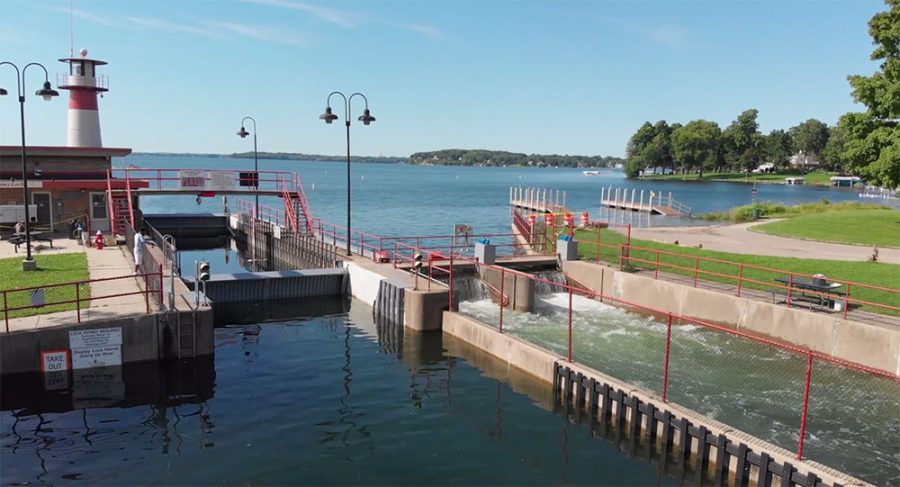It’s time to lower the lake
There is no good reason to keep Lake Mendota at an artificially high level
Recent flooding should convince political leaders that it’s time to lower the level of Lake Mendota.
September 26, 2018
Unless you just woke up from a coma, you’ve heard it far too often over the past few weeks: Madison has had some flood problems. Homes, parks, and businesses alike have suffered the ravages of late August to early September rainstorms. For weeks, water over-flowed with seemingly nowhere to go. Only now, as the water recedes, is the capital city regaining a sense of normalcy.
In many places, floods worsen year by year, as wetlands that once naturally soaked up rain water are filled in to accommodate new development. I’m familiar with this kind of flood. I witnessed it in 2008, in my hometown.
The village of Oregon, Wisconsin has no natural advantages against rain. When people first built their homes in the swamp south of Madison, God must have looked down and wondered if they’d learned nothing from the tale of Noah. In 2008, the developers’ hubris was made apparent, as record setting rains swept down from the hills, and pooled downtown. Soccer fields were submerged, businesses closed temporarily, and dozens upon dozens of basements filled with water.
The damage was worst near Badfish Creek, where such water would normally drain. On one cul-de-sac adjacent to the stream, every house was totaled. The water damage was so bad, the Village agreed to buy the residents out. The houses were then levelled, and the street was ripped up, so no one could ever build there again. The name of that flood prone, ill-advised disaster of a street, ironically, was Florida Avenue. It’s almost as if the developers knew it was a bad idea from the very beginning.
Since that incident, a decade of rain has washed over Oregon, and it hasn’t had real flood problems since. Unfortunately, Madison can’t solve its current problems in a similar way. If the City tried to buy out every flood prone property, it wouldn’t have money to do much else for decades. However, there’s another solution within easy reach: Lower the water level of Lake Mendota.
The Yahara’s largest lake is kept artificially higher by a dam, even though the time when that was necessary has long passed. Lake Monona and Mendota’s relationship used to be very different, the twin lakes were much closer to the same height. The river that cuts across the isthmus today basically didn’t exist. Instead, the water flowed over a wide swath of marsh. All of that changed a 170 years ago, when the first water powered mill was built.
To get a strong and consistent flow, there needed to be a difference between the heights of the lakes. The first dam was built where Tenney Park is now, and the Yahara River channel was dredged into its recognizable shape. This was all great for making bread, or whatever the mill did, but no such industry exists on the Yahara today. Nobody’s livelihood depends on that flow of water anymore, but many people’s lives could be ruined if parts of Madison flood again. The river channel can stay, but the upstream lake should be lowered to its pre-industrial height to be able to hold future downpours.
Of course, I say this all naively, thinking the city can just open the Tenney Dam and fix this problem in a day. In practice, I know that can’t happen, thanks in large part to the complaints of people who live on the lake and own boats.
No matter what happens to people downstream, every time a flood comes and lowering the lake is discussed, the same objections arise: It would be expensive to extend existing docks further into a now smaller lake, and boats would run aground frequently on newly exposed hazards.
These are valid criticisms, but I think the lake house owners overlook some benefits. Namely, once the lake falls, many people would be the proud owners of a new beachfront. Mendota actually hides quite a bit of sand under its surface. Its beaches were part of what drew the first people to build summer cabins there, then the sand was covered up when the mill moved in. Yes homeowners, moving your dock to match the draining of the lake would be inconvenient, but maybe the change could be made in fall, when you have to pull your dock out anyway. You’d barely notice the difference next spring.
With heavy rains becoming more frequent in our area, the city of Madison needs to take steps to prepare for the next big storm. Hopefully the recent flooding incident can help spur us to action. Hindsight, as people often say, is 20/20. If we let our past inform our decisions, perhaps by the year 2020 the isthmus will never have to fear preventable floods again.































